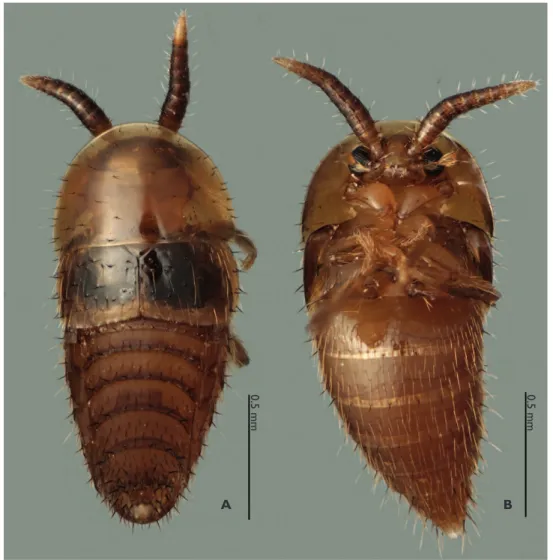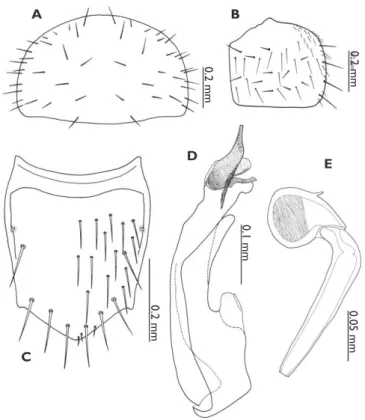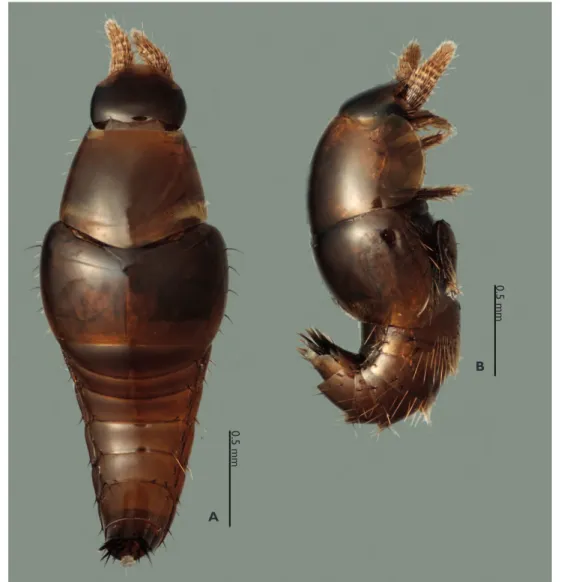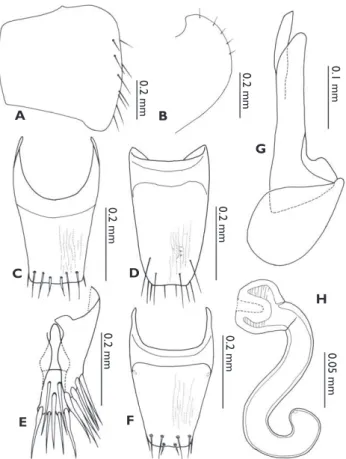Two new species of Aleocharinae
(Coleoptera, Staphylinidae) found in fungus
gardens of
Odontotermes
termites (Isoptera,
Termitidae, Macrotermitinae) in
Khao Yai National Park, Thailand
Taisuke Kanao1,†, Munetoshi Maruyama2,‡, Watana Sakchoowong3,§
1 Entomological Laboratory, Graduate School of Bioresource and Bioenvironmental Sciences, Kyushu Universi-ty, Fukuoka, 812-8581 Japan 2 h e Kyushu University Museum, Fukuoka, 812-8581 Japan 3 Forest Entomo-logy and MicrobioEntomo-logy Group, National Park, Wildlife and Plant Conservation Department, 61 Praholyothin Road, Chatuchak, Bangkok, 10900, h ailand
† urn:lsid:zoobank.org:author:38A7BB31-AD25-4C09-B8DC-47535DC5D417
‡ urn:lsid:zoobank.org:author:2F8BEE60-1C25-42BB-8D59-AA71D7EB7141
§ urn:lsid:zoobank.org:author:69C25ADF-D082-40F2-A9B6-62AA9EB4C5A9
Corresponding author: Munetoshi Maruyama (dendrolasius@gmail.com)
Academic editor:Jan Klimaszewski | Received 26 April 2010 | Accepted 4 May 2010 | Published 18 June 2010
urn:lsid:zoobank.org:pub:238DC6E5-19F5-4641-A2ED-BCC942AFFCAC
Citation: Kanao T et al. (2010) Two new species of Aleocharinae (Coleoptera, Staphylinidae) found in fungus gardens of
Odontotermes termites (Isoptera, Termitidae, Macrotermitinae) in Khao Yai National Park, h ailand. ZooKeys 49: 77–86.
doi: 10.3897/zookeys.49.468
Abstract
Discoxenus katayamai sp. n. and Odontoxenus thailandicussp. n. are described from Khao Yai National Park, East h ailand. Both species were collected from nests of termite of the genus Odontotermes Holm-gren, 1912. h ese are the i rst records of both genera from h ailand. Discoxenus katayamai is similar to
D. indicus Wasmann, 1904, and O. thailandicus is similar to O. butteri (Wasmann, 1916). Each species is easily distinguished from their congeners by the body size, the number of the setae on the pronotum, elytra and abdomen and other characters discussed below.
Keywords
New species, Odontotermes, Compactopediina, Aleocharini, Pygostenini, Discoxenus katayamai sp. n.,
Odontoxenus thailandicus sp. n., termitophily
Introduction
Many species of insects are known to be associated with termites, and especially with fungus-growing termites of the genus Odontotermes Holmgren, 1912, which is a host for various groups of termitophiles in their fungus gardens, e.g., beetles, l ies and sil-veri sh (Wasmann 1904, 1912, 1916; Kistner 1969). David H. Kistner investigated the termitophile fauna in Khao Yai National Park, h ailand, and reported some new species of staphylinid beetles (Kistner and Newton 1999; Jacobson and Kistner, 1999) and a few scuttle l ies (Disney and Kistner 1997). However, no staphylinid beetles as-sociated with Odontotermes termites have been reported from h ailand.
In 2007, the junior author and his colleagues investigated termitophilous insects in Khao Yai National Park, and they found several new species of termitophiles. Two of them are described new species of staphylinid beetles, one in the genus Discoxenus (Wasmann, 1904) belonging to the tribe Aleocharini and one in Odontoxenus Kist-ner, 1958 belonging to the tribe Pygostenini. All the specimens were found in fungus gardens of Odontotermes termites; both genera have not been previously known from h ailand.
h e genus Discoxenus was described by Wasmann (1904) to accommodate two species from India. Later Wasmann (1916) described two species from Sri Lanka. Kist-ner (1975) revised the genus and added three species from India, Malaysia and Myan-mar. h us, seven Discoxenus species have been known in the Oriental Region.
h e genus Odontoxenus was established by Kistner (1958) for 12 species originally described as the members of Doryloxenus Wasmann, 1898 by Wasmann (1904, 1916), Cameron (1926, 1932), Kemner (1929), and as Mimocete Fauvel, 1899 by Fauvel (1899). Later, Jacobson and Kistner (1975a) added one species and Jacobson and Kist-ner (1975b) reviewed the genus. Later, KistKist-ner (2005) described one new species from Malaysia. Up to now, 14 species have been described from India, Sri Lanka, Indonesia and Malaysia.
Material and methods
h e i eld research was conducted in 2007, by M. Maruyama, Yûji Katayama and Ta-kashi Komatsu in Khao Yai National Park, 30 km northeast of Bangkok. h e fungus garden was carefully removed from the nest and crushed little by little on a white plastic tray to i nd symbiotic insects. h e insects were observed and photographed on fragments of the fungus garden. h ey were i nally put in 2 ml vials with 80% ethanol.
h e technical procedures used here are generally as described in Maruyama (2006). Measurements are all in millimeters with averages and standard variations in parentheses.
Number of macrosetae is coni ned to both sides of the body, except for that of tergite IX on one side of the body.
h e symbiotic termite was identii ed by Yoko Takematsu. However, the current taxonomic status of the genus Odontotermes is still not settled, and the identii cation of the termite species in this paper is tentative (Takematsu, personal communication).
Holotypes and most of the paratypes of new species are deposited in the Kyushu University Museum (KUM), and some of paratypes are deposited in the National Park, Wildlife and Plant Conservation Department, h ailand (DNP).
Taxonomy
Genus Discoxenus Wasmann
Wasmann 1904: 655 (original description); Kistner 1982: 165 (revision).
Comments. h is genus is similar to Compactopedia Kistner, 1970, associated with ter-mites of the genus Longipeditermes Haviland, 1898 in Malaysia, from which Discoxenus is distinguished by the body being smaller, the antennae being thicker and the tarsal formula 4-4-5 (Kistner 1982). It is new record from h ailand.
Discoxenus katayamai Kanao & Maruyama, sp. n.
urn:lsid:zoobank.org:act:CE782948-FE3C-4809-B2F2-CA09C7196C2A
Figs 1, 2, 5C
Type series: Holotype: ♂, “h ai: Nakhon Nayok, Khao Yai National Park, Mo Sing To (700 m alt.), 26 IX 2007, Maruyama M. and Katayama Y. leg. // Holotype Discox-enus katayamai des. Kanao & Maruyama, 2010”, abdomen dissected and mounted in Euparal (KUM). Palatypes: 2♀, 23 sex?, same data as holotype; 8 sex?, ditto, but 28 IX 2007 (KUM, DNP).
Symbiotic host: Odontotermes proformosanus Ahmad, 1965.
Etymology: Dedicated to Y. Katayama, a collector of the type series.
Diagnosis. h is species is similar to D. indicus through the shape of the me-dian lobe of the aedeagus, but may be distinguished from it by the shorter body and by the number of setae on tergites III and IV, six setae on each. h e smallest species of the genus.
Figure 1.Habitus of Discoxenus katayamai. A dorsal view and B ventral view.
as wide, blunt at apex. Elytron (Fig. 2B) 2/3 as long as pronotum, with a row of 4 macrosetae, about 10 setae on lateral margin, and with 10–11 macrosetae and about 30 setae on dorsal surface. Abdominal tergite VIII (Fig. 2C) with 4 pairs of macrosetae along lateral margins and 14–15 pairs of setae on dorsal surface; macrochaetotaxy of abdominal tergites II–VIII: 0, 6, 6 (7), 6, 6, 6, 8; each sternite (Fig. 1B) with macrosetae on posterior marginal row. Median lobe of aedeagus elongate (Fig. 2D); apical lobe slightly curved paramerally; distal crest well pro-duce. Spermatheca (Fig. 2E) with apical part swollen, its inner wall densely wrin-kled from apex to around apical 3/5 of its length; basal part twice as long as apical part and slightly curved near apex.
Measurements. Body length: ca. 1.8–2.2; pronotal length: 0.41–0.56 (0.46±0.053); pronotal width: 0.70–0.82 (0.75±0.046); antennal length: 0.54–0.65 (0.62±0.045). N=10.
A
0.5 mm 0.5 mm
Genus Odontoxenus Kistner
Kistner 1958: 104 (original description); Jacobson and Kistner 1975: 293 (key, diag-nosis).
Comments. h is genus in general appearance and body size is similar to Doryloxenus among the Asian genera of Pygostenini, but distinguished from it by the shape and position of eyes having part of their surface on the anterior margin of the head, the relatively long mesosternum, and the reduced 4-segmented tarsi (Jacobson and Kistner 1975).
Odontoxenus thailandicus Kanao & Maruyama, sp. n.
urn:lsid:zoobank.org:act:EF7AED85-A974-4EE3-9144-D5B6B6BDE487
Figs 3, 4, 5D
Type series. Holotype: ♂, “h ai: Nakhon Nayok, Khao Yai National Park, Mo Sing To (700 m alt.), 28 IX 2007, Maruyama M. and Katayama Y. leg. // Holotype Odon-Figure 2.Discoxenus katayamai. A pronotum B elytron C abdominal tergite VIII D median lobe of aedeagus, in lateral view, andE spermatheca.
0.2 mm
0.1 mm
0.2 mm 0.05 mm
0.2 mm
B A
D
E
toxenus thailandicus des. Kanao & Maruyama, 2010”. Palatypes: 2♀, same data as holotype; 2♂, 2♀, ditto, but 26 IX 2007.
Symbiotic host: Odontotermes proformosanus Ahmad, 1965
Etymology. Named after the type locality.
Diagnosis. Most similar to O. butteri (Wasmann, 1916) and O.malaysianus Kist-ner, 2005 through the pronotum with a row of macrosetae at the lateral margin, but dis-tinguished from them by the macrochaetotaxy of the tergites II–VIII: 0, 2, 2, 2, 4, 6, 8.
Description. Body (Figs 3A–3B) almost uniformly reddish brown; head and elytra slightly darker. Dorsal surfaces of head, pronotum and elytra (Fig. 3A) smooth, glossy and glabrous. Head to elytra (Fig. 3B) well convex, laterally curved in shape of half
cir-Figure 3. Habitus of Odontoxenus thailandicus. A dorsal view and B lateral view.
0.5 mm
0.5 mm
B
cle. Pronotum (Figs 3A–3B, 4B) much narrower than elytra, with a row of 5 macrose-tae on lateral margin. Elytra (Figs 3A–3B, 4A) with inl exed lateral margins, and about 10 macrosetae on lateral margins. Macrochaetotaxy of abdominal tergites II–VIII: 0, 2, 2, 2, 4, 6, 8; male abdominal tergite VIII (Fig. 4C) slightly truncate at apex and slightly wrinkled on dorsal surface, with 3 pairs of macrosetae near apex (1 laterally, 2 dorsally), and with 1 pair of l attened setae at apex; sternite VIII (Fig. 4D) with 2 pairs of macrosetae on dorsal surface and 3 pairs at apex; female tergite VIII (Fig. 4F) with basal projections and macrosetae shorter than in male. Tergite IX (Fig. 4E) with 7 pairs of macrosetae laterally; tergite X (Fig. 4E) with 3 macrosetae around middle and 2 pairs of macrosetae at apex. Median lobe of aedeagus (Fig. 4G) with apical lobe almost straight, much narrower than basal capsule; copulatory piece membranous; basal capsule swollen, half as long as apical lobe. Spermatheca (Fig. 4H) curved twice, S-shaped; apical part swollen, its inner wall hollowed at apex, densely wrinkled from apex to around apical 1/3; basal part 2.5 times as long as apical part, roundly curved around basal 1/3 and gently curved around apex.
Figure 4.Odontoxenus thailandicus. A elytron B pronotum C male abdominal tergite VIII D male ab-dominal sternite VIII E male abdominal tergite IV & V F female abdominal tergite VIII G median lobe of aedeagus, and H spermatheca.
0.2 mm 0.2 mm
0.2 mm
0.2 mm
0.2 mm
0.1 mm
0.2 mm
0.05 mm
C
A B
G
H
F E
Figure 5.AOdontotermes proformosana, queen, workers and soldiers B the fungus garden of O. profor-mosanaCDiscoxenus katayamai, on fungus gardenDOdontoxenus thailandicus, on fungus garden. Photos © Y. Katayama (5A–5B), T. Komatsu (5C–5D), 2007.
Measurements. Body length: ca. 1.7–2.0; pronotal length: 0.44–0.51 (0.47±0.031); pronotal width: 0.64–0.73 (0.68±0.037); antennal length: 0.29–0.30 (0.30±0.012). N=5.
Biological notes
h ese new species were found in the fungus gardens of Odontotermesproformosanus (Figs 5A–5B). h e scuttle l ies Clitelloxenus perdosetae Disney, 1997, C. thailandae Disney, 1997, Franssenia sp., Crasilla sp. and Dicranopteron sp. were also caught at the same time. h e individual number of each species was very low, compared to D. malaysianus collected in a high number from a few Odonototermes Holm-gren, 1912 nests in Malaysia (Kistner 1982). Only a few specimens of D. katayamai (Fig. 5C) were found in one nest, which generally contained one to ten, i st-sized fungus gardens, and none or one specimen of O. thailandicus was found in one nest, though density of the host termites was very high at Mo Sing To, the type locality of the present new species. h e behavior of D. katayamai was almost the same as it was reported for D. malaysiensis by Kistner (1982). h e behavior of O. thailandicus
A B
D
(Fig. 5D) was similar to that of D. katayamai, but it moved much slower than D. katayamai and it often stopped.
Acknowledgment
We would like to express our thanks to Professor Osamu Tadauchi, Associate Professor Satoshi Kamitani, Associate Professor Layne Westover for reviewing the manuscript. We are also indebted to Mr. Narong Mahannop, the superintendent of Khao Yai Na-tional Park, for supporting and provisioning our i eldwork. Permission for sampling in this project was granted by the National Park, Wildlife, and Plant Conservation Department, h ailand (No. 0907/14255). T. Kanao and M. Maruyama thank Dr. Yoko Takemastu for identii cation of the termite species. M. Maruyama thanks Alfred F. Newton and Margaret K. h ayer for allowing use of the Microptics system at the Field Museum of Natural History, and Y. Katayama and T. Komatsu for their assist-ance in the i rst author’s i eld work and for taking excellent pictures (Figs 5A–5D). h is study was partially supported by a JSPS Postdoctoral Fellow for Research Abroad to M. Maruyama. h is is a Contribution from the Entomological Laboratory, Faculty of Agriculture, Kyushu University, Fukuoka (Ser. 6, No. 86).
References
Ahmad M (1965) Termites of h ailand. Bulletin of the American Museum of Natural History 131: 1–111.
Cameron M (1926) New species of Staphylinidae from India, Part 3. Transaction of Entomo-logical Society of London 74: 171–191.
Cameron M (1932) Staphylinidae, 3. Fauna of British India.
Disney RHL, Kistner DH (1997) Revision of the oriental Termitoxeniinae (Diptera: Phoridae). Sociobiology 29: 3–118.
Fauvel A (1899) Genres et espèces de Staphyinides nouveaux d’Afrique. III. Sur une Tribu nou-velle Staphylinides (Pygostenini) et descriptions de genres et espèces. Revue d’entomologie. 18: 1–44.
Haviland GD (1898). Observations on termites; with descriptions of new species. of the Lin-nean Society (Zoology) 26: 358–442.
Holmgren N (1912) Termiten Studien. der Termiten. Die Familie Metatermitidae. Svenska Vetensk. Akad. Handl (4): 1–166.
Jacobson HR, Kistner DH (1975) A manual for the indication of the Pygostenini, the natural history of the myrmecophilous tribe Pygostenini. Sociobiology 1: 201–335.
Kemner N (1929) Die Lebensweise des Doryloxenus auf Java und Waasmann’s Hypothese über seinen Wirtswechsel. Entomologisk tidskrift 50: 214–223.
Kistner DH (1958) h e Evolution of the Pygostenini (Coleoptera Staphylinidae). Annalen Du Musée Royal du Congo Belge Tervuren (Belgique). 68: 1–198.
Kistner DH (1969) h e Biology of Termitophiles. In: Krishna K and Weesner FM (Eds), Biol-ogy of Termites 1. Academic Press, N.Y. 525–557.
Kistner DH (1970) New termitophiles associated with Longipeditermes longipes (Haviland) II. h e genera Compactopedia, Emersonilla, Hirsitilla, and Limulodia. Journal of the New York Entomological Society 78 (1): 17–32.
Kistner DH (1982) A revision of the termitophilous genus Discoxenus with a study of the rela-tionships of the genus and notes on its behavior (Coleoptera, Staphylinidae). Sociobiology 7: 165–186.
Kistner DH (2005) A new species of Odontoxenus from Malaysia (Coleoptera: Staphylinidae: Aleocharinae: Pygostenini). Sociobiology 45: 209–213.
Kistner DH, Newton AF (1999) A new genus and species of termitophilpus Osoriinae from h ailand (Coleoptera: Staphylinidae) with notes in its behavior and that of associated ter-mitophiles. Sociobiology 34: 239–248.
Wasmann E (1898) Ein neue dorylophile Tachyporinen Gattung aus Südafrika. Wiener ento-mologische Zeitung 17: 101–103.
Wasmann E (1904) Zur Kenntnis der Gäste der Treiberameisen und ihrer Wirthe am obern Congo nach den Sammlungen und Beobachyungen von P. Herm. Kohl, C. S. S. C. bear-beitet. Zoologische Jahrbücher 7: 611–682.
Wasmann E (1912) Neue Beiträge zur Kenntnis der Termitophilen und Myrmekophilen. Zeitschrift für wissenschaftliche Zoologie101: 70–115.




